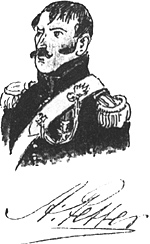Netherlands Artillery
in the Waterloo Campaign
Part II:
The Netherlands Artillery Officers
Abraham Petter
reviewed by Geert van Uythoven, The Netherlands
| |

Petter was born in ‘s Hertogenbosch (present day Netherlands) on 7 July 1776. On 1 August 1792, he joined the 1st Swiss Infantry Regiment ‘De Gumoëns’ in Dutch service, as a volunteer. In 1793 and 1794 he took part in the campaigns in Flanders and France. Transferred to the horse artillery on 20 August 1795 as a gunner. In 1796 he was a brigadier with the horse artillery, present with the Batavian army in Germany. On 5 July 1797 Petter embarked in Den Helder on a fleet destined to invade Ireland, being a fourier. Nothing came of it, and the troops were disembarked on 26 September again. In 1799 Petter participated in the campaign in North-Holland as a sergeant with the horse artillery. He was promoted to sergeant-major. He took part in the 1800 – 1801 campaign on the Main, and was promoted to 2nd lieutenant-adjutant (27 March 1801), later 1st lieutenant-adjutant (29 October 1804). He embarked in 1805 at Den Helder for the expedition to England, but nothing came of it. He took part in the 1805 campaign in Germany. As a 2nd captain, Petter was appointed to Horse artillery battery no.2 (28 November 1806). Already in October 1806 this company, commanded by Captain Johan Simon Pistor, was assigned to the 3rd (Dutch) Division (Lieutenant-General Jean Baptiste Dumonceau), taking part in the capture of the fortresses Hameln and Nienburg. After that, the company was assigned to the 2nd Division (Général de Division Pierre-Louis Dupas) of Marshal Adolphe-Edouard-Casimir-Joseph Mortier’s VIII Army Corps. He was present at the Siege of Kolberg. On 8 August 1808 he was promoted to 2nd captain and appointed with the horse artillery by King Louis Bonaparte. He took part in the campaign in Northern Germany 1809 against Von Schill. On 31 May Stralsund, the fortress-city in which Von Schill had sought refuge, was attacked by Dutch troops and a Danish auxiliary corps. Petter received command of all four howitzers of the Horse artillery batteries no.1 and no.2, and was one of the first to open fire, later reinforced by the remaining cannon of the horse artillery. The horse artillery fought a two hours long duel with the 24-pdrs on the city falls, covering the assault on the city. In August of that year, the Horse artillery company no.2 returned to Holland, and after the British landings in Zeeland (Walcheren) the company was assigned to Marshal Jean Baptiste Dumonceau’s corps around Bergen op Zoom. On 13 November 1809, Petter transferred to the foot artillery, and when the Kingdom of Holland became a part of the French Empire, he became a captain-commander in the 9th Artillery regiment on 20 December 1810. In 1814 he joined the Netherlands army. The exploits of Petter during the Waterloo campaign will be described in part 3 of this series. For his service during the Waterloo campaign, Petter was appointed a knight 4th class of the Militaire Willemsorde (‘Military order of William’) on 18 July 1815. During the last days of November Petter marched his battery back to the Netherlands, being garrisoned in Bergen-op-Zoom. Next month on 8 December 1815 he was promoted major. On 11 October 1820 he transferred to the 1ste Bataillon Artillerie Nationale Militie, promoted to lieutenant colonel. He died in Kampen on 1 June 1865. Netherlands Artillery in the Waterloo Campaign 1815 Part II: Artillery Officers
Adriaan Bijleveld David Esaias Bode (Boode) Lodewijk Hendrik Du Bois A.Willem Du Pont Adrianus Rudolf Willem Gey Carel August Gunkel (Gunckel) Godfried Jacob Holsman Nicolaas Lodewijk Kaempfer Carel Frederik Krahmer de Bichin Martinus Antonius Kuytenbrouwer Frederik Carel List Johannes Hendrik Lux Prince (William) Frederick Carl van Oranje-Nassau (Willem Frederik Karel, Prins der Nederlanden) Abraham Petter Carel Jan Riesz Johan George Hendrik Scheffer Jacques-Louis-Dominique, Baron van der Smissen Johannes Nicolaas Spies Maximilian-Henry Steenberghe Emmanuel-Joseph Stevenart Hendrik Rudolph Trip Pieter Wijnands Leopold Winssinger Netherlands Artillery in the Waterloo Campaign 1815 Part I [FE71]
The Artillery in the Southern Netherlands The Artillery Arm in the Kingdom of the Netherlands Equipment and The Train Unit Info and Roster (very slow: 377K) Back to Table of Contents -- First Empire # 72 Back to First Empire List of Issues Back to MagWeb Master Magazine List © Copyright 2003 by First Empire. This article appears in MagWeb.com (Magazine Web) on the Internet World Wide Web. Other articles from military history and related magazines are available at http://www.magweb.com |